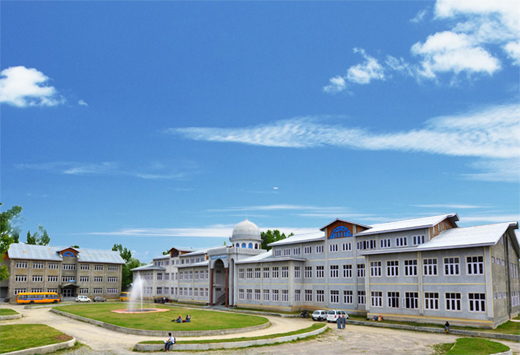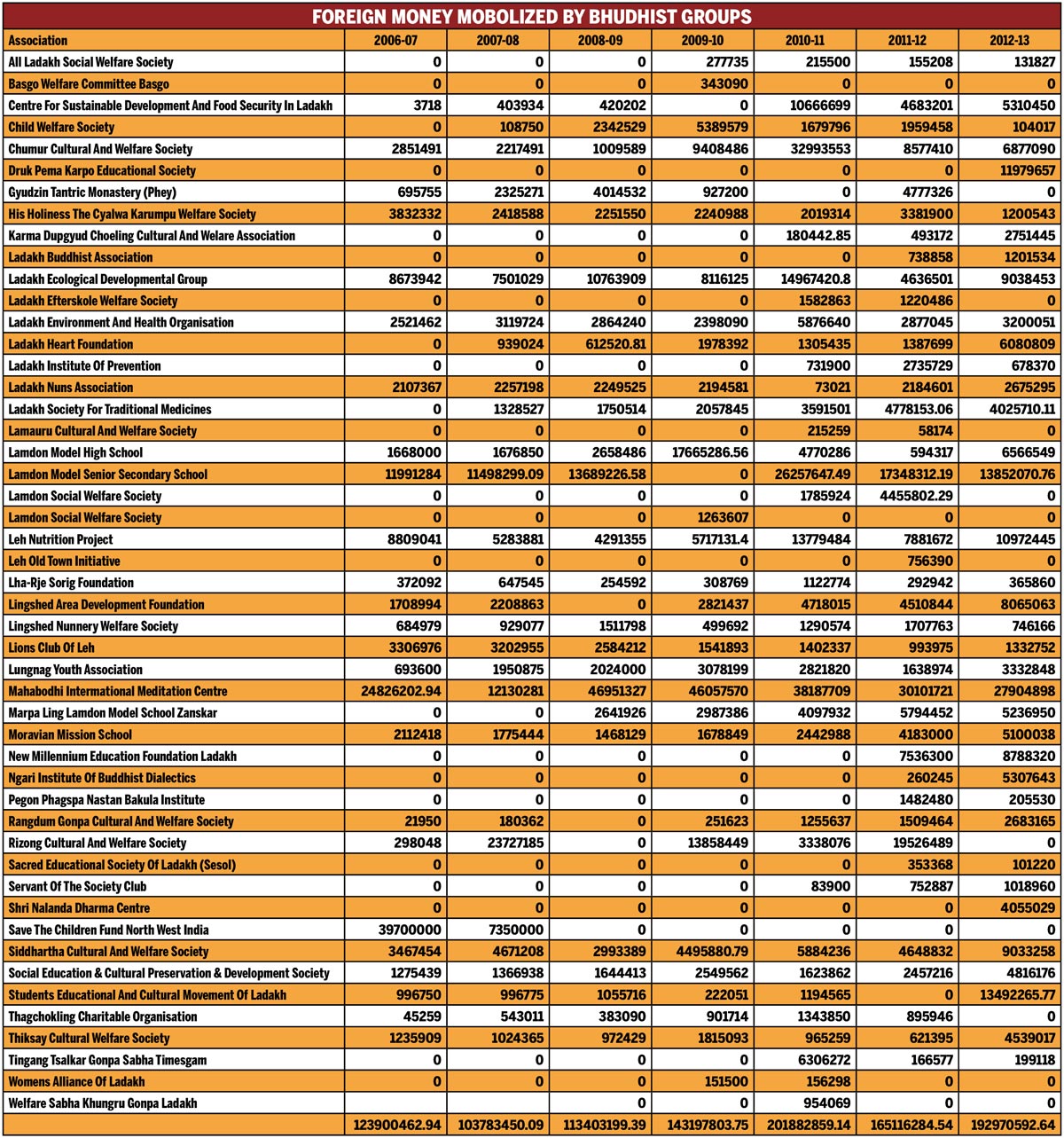A general belief that Christian minorities are mobilizing off-shore resources to manage their activities in J&K is not a fact. The Buddhist minority concentrated in Leh is the main puller of foreign aid for the last many years now. But why is Kashmir unable to manage a respectable pie when its strife-created crisis should have made it a better player, investigates Riyaz Ul Khaliq

In 2011-12, 22702 Non-Governmental Organizations (NGO) in India mobilized an amount of Rs.11546.29 crore from foreign donors. Imagine how much the J&K got? Only Rs 33.52 crore that 102 groups mobilized.
And where did this money go? Groups that are directly or indirectly linked to the evangelical activity and Christian welfare matters have received Rs 8.17 crore. The whopping amount of Rs 16.51 crore has gone to Leh district of J&K and mostly mobilized by NGOs managing the socio-economic affairs of the Buddhist minority. The rest has gone to various Hindu groups across the state and Muslims in Kargil and Kashmir.
These statistics demolish the myth that Christians take the lion’s share from abroad. The dynamics of foreign aid at non-state level is completely changed. Data computed on basis of the returns that these groups have filed with the Ministry of Home Affairs (MHA) under Foreign Contributions Regulations Act (FCRA) suggest that in 2012-13 out of Rs 29.63 crore that J&K mobilized from overseas donors, only Rs 7.62 crore has been received by possible Christian groups as Rs 19.29 crore went straight to Leh.
Given the fact that managing foreign aid essentially means working on the ground and convincing global donors to support the initiative, does the prevailing situation suggest Kashmir has failed? Usually, societies that are in conflict or gradually coming out of that, have more social problems to tackle as the state actors are not able to manage all this. It is at this level that the foreign aid comes to the rescue.
 In Kashmir, many known and unknown NGOs – so many say the number is running in tens of thousands, are apparently working. Most of them claim they rehabilitate victims of the violence. Some of them work on other social sectors like education, water availability, agriculture and encouraging small enterprises.
In Kashmir, many known and unknown NGOs – so many say the number is running in tens of thousands, are apparently working. Most of them claim they rehabilitate victims of the violence. Some of them work on other social sectors like education, water availability, agriculture and encouraging small enterprises.
Kashmir has been in turmoil since 1989. It has created a lot of destitution. There are more than 200 thousand orphans and nearly forty thousand widows. Are foreign donors not willing to help Kashmir NGOs in managing this load? Some of the players in the field think they know the answers.
Working since 1970, Jammu and Kashmir Yateem Trust has been looking after orphans. The rise of militancy only added to its capacity and load. Over the years, it has been helping marry off poor girls, students to get education and sponsoring vocational programmes to the destitute and needy.
“Save the Children, Action Aid and UK based Muslim Aid are the main foreign donors of JKYT,” Zahoor Ahmad Tak, the Trust Patron said. “There are many hurdles in getting the foreign aid. You must know, it is Kashmir.”
“There are hurdles in mobilizing resources as monitoring is intense,” Tak said. “Because of the conflict, the government doesn’t allow it though things have been changing.”
Tak said the money his group is mobilizing is being spent on socio-psycho rehabilitation of the victims of the conflict. The children are getting dietary assistance too. His group’s focus areas include Bandipora, Baramullah, Kupwara and Pulwama. “A lot of resources are required for victims of violence but donors too are quite a few and are apprehensive and then the government nod is mandatory,” Tak said avoiding to detail why donors are ‘apprehensive’.
A fastest growing group, Jammu and Kashmir Yateem Foundation (JKYF) is another major player in the destitute-management. It started after militancy showed the costs it entails.
An official of the Foundation said foreign donors have their own ‘aims’ so at times it is not possible to work with them. “Foreign funding agencies have their own motives which, at times, cannot be agreed upon,” he said. His group send projects to foreign donors for sponsorship and the donors retain the first right in deciding the ‘aim and modus operandi’.
Since 2006, JKYF is getting money from Save the Children Fund, Action Aid, Mercy Universal London and some sponsorship from Canada based HCI. Most of the resources that JKYF managed were a reaction to emergency situations.
Set up in 1997, Jammu and Kashmir Help Foundation (JKHF), run by Nighat Shafi, wife of former IAS officer Shafi Pandit, is working on education, mental health and women empowerment. They also receive foreign aid. “Unless we don’t know the credentials of an individual or organization that agrees to work with us, we don’t accept help,” Ashiq Ali, a Foundation official said.
Working on education and rehabilitation, Chinar Nurture and Relief claims is also receiving foreign aid. They say their main source is Kashmiri Diaspora. “We have been working on education of destitute and conflict victims,” Nazir Ahmad Qureshi, its head, said. Housing 18 orphans at its Baghat facility in Srinagar, Quereshi said they are constructing their own building in Khanpora (Budgam). “We have 60 more students who are day comers whom we help in studies financially.”
Iqbal Memorial Trust (IMT) that runs a chain of well-established schools and a junior technical college is also a recipient of foreign contributions. It also has a wing helping poor and needy. But its chairman Dr Yusuf Ul Umar was not available for his comments. “I am out of the station,” he said.
There is She Hope Society for Women Entrepreneurs (SHSWE) that is avowedly working for rehabilitation of specially-abled persons besides working in handicrafts sector by helping artisans. It is based in remote Wayil belt of Ganderbal and is mobilizing one to Rs 1.5 crore from abroad annually.
“We have a complete Limb manufacturing unit at our head office at Wayil, Ganderbal where we admit patients and help them recover,” Sami Wani, SHSWE Executive Director said. “Those persons who are unable to recover are taken due care and a monthly scholarship is granted to them for studying or a self-employment unit is established for them.”
Wani claimed though hundreds of NGOs are working in Kashmir only two percent of them are actually working. “We (NGOs in Kashmir) do not work with sincerity and transparency,” he asserted. “Foreign aid is routed through MHA only after credentials of aid-seekers are verified. It is not an easy job.” He said there is lot of scope for people to mobilize foreign aid as long as they work.

Pic Bilal Bahadur
Wani said he is amused seeing people showing ‘work done’ when actually they do nothing. “Our (NGOs) credibility has got eroded because we have colourful claims but no work,” he said. “This is the reason that international organizations don’t trust Kashmiris and we are not able to get donors.” Handicap International and New Zealand based MEND are SHSWEs main foreign donors.
Trying to explore other players in the field, it seems Wani is not incorrect. There are many groups receiving foreign aid but may require putting in more efforts to get counted on the ground.
S R Institute of Development (SRID) is a rare NGO that claims to be establishing water hand pumps. It operates from a run-down building in congested Rambagh. Housing in the topmost floor, this one room NGO lacks any signboard. After hectic effort, when Kashmir Life managed to reach the office, a lady staffer and a young boy greeted the team. A few hundred books on the shelves, the lady staffer informed the NGO solely works on education sector which is contrary to what their website claims. “No, we work on education,” she said while contacting her boss.
When contacted Riyaz Ahmad Malik, the head of SRID said his NGO has been running preparatory schools in Baramullah, Bandipora and Budgam with about 25 centres besides family counselling centres. “We educate people about domestic violence and child rights,” Malik said. “We establish water hand pumps where there is water scarcity.” He claimed to have installed established two water hand pumps in SKIMS, Soura and Imam Bara, Zadibal.
Foreign aid (it has received Rs 38.60 lakh during last financial year) apart, SRID, according to Malik, is very active in implementing Government of India funded projects like NHRM. “We are giving scholarships and helping destitute and needy,” he said. “We hold vocational training camps also.”
Run by a woman, The New Kashmir Women’s and Child Welfare Society (NKWCWS) runs from top floor room of a building at Bazaar-e-Batamaloo. “We make people aware about women health, development and entrepreneurship,” said Ms Mahjabeen who heads the NGO. “We are trying to be a medium between people and authorities.” In the last three years, this group has filed returns with MHA suggesting it received Rs 3.33 crore. Her donor includes Action Aid.
Compared to this situation, a cursory look at Leh suggests a very positive picture. Most of the money goes to the region but the NGO working in the arid desert have put in lot of efforts to trigger a larger change on socio-economic front.
Take for instance, Mahabodhi International Meditation Centre that was founded in 1986 by a soldier Venerable Bhikkhu Sanghasena. It has brought a change in the education sector and laid strong foundation for safe shelter for underprivileged children, first-class healthcare for the sick and needy, empowerment and literacy programmes for women and other socially disadvantaged groups, a caring home for the aged and destitute, and many other humanitarian services. The site for much of Venerable Bhikkhu Sanghasena’s humanitarian and spiritual service work has been the 200 acres of moon-like desert that now form the impressive backdrop to the main Mahabodhi Devachan campus in Choglamsar, Ladakh.

It has a vast network of educational institutes across Leh and has established hostels in Chandigarh for students who study there. The NGO that has received Rs 22.61 crore of foreign aid in last six years has established water projects to tap water in Ladakh. Besides, it has established solar power plants to help the energy-deficit belt.
There are scores of such groups working in Leh. Some NGOs have emerged as model groups on sectors like education and renewable energy. The government is so liberal in managing Leh’s requests is that even Ladakh Buddhist Association (LBA) – the organization that was key to the worst communal riots and social boycott of Muslim minorities in 1989, is also permitted to manage foreign aid. In last two years, LBA has mobilized Rs 19.40 lakh from abroad!
Over the years the foreign aided NGOs have emerged as an industry in Leh to the extent that various officers who have worked in the area say they have become the new vested interest group in the region. At one point of time, when a DC rank officer – who functions as ex-officio secretary of the LAHDC, started enforced some systems, the move was resisted.
Leh has emerged as a model for neighbouring Kargil. Kargil Educational Society, actually Mutahary Educational Society, is one of the most impressive educational networks in the district. Part of its success goes to the mobilization of offshore resources. It mobilized Rs 3.34 crore in last seven years and the results are there on the ground.

















